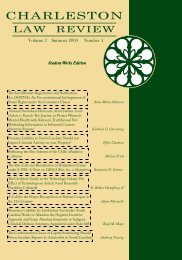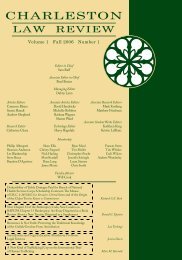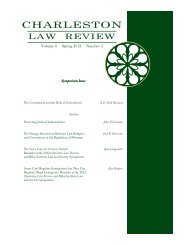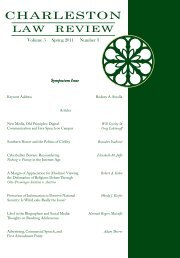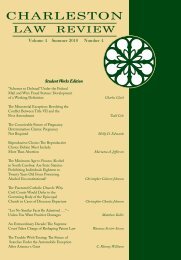Volume 5 Winter 2011 Number 2 - Charleston Law Review
Volume 5 Winter 2011 Number 2 - Charleston Law Review
Volume 5 Winter 2011 Number 2 - Charleston Law Review
Create successful ePaper yourself
Turn your PDF publications into a flip-book with our unique Google optimized e-Paper software.
SCHULZE FINAL.doc1/20/<strong>2011</strong> 6:14PM<strong>2011</strong>] <strong>Law</strong> School Academic Supportdemonstrate this principle, consider a pedagogy lacking a focuson these values. The traditional law school pedagogy dealsalmost strictly with the “zero-sum game” model of litigation,leaving students with the sense that every legal matter results ina clear winner and a clear loser. This situation emanates fromthe casebook model of teaching, where students learn everythingthey know about law by reading the details of litigated cases inwhich, ultimately, one party was the conqueror while the otherwas the vanquished. Even in conflicts with subtle shades of gray,where several parties may be somewhat blameworthy, theclassical view would declare one party the winner and one partythe loser often based upon a hyper-technical classification of theparty’s actions into one legal doctrine or another. Often neophytelaw students (and even experienced attorneys) are aghast at theseemingly random results of cases that seem contrary to theirinitial sense of the morally correct outcomes. We teach them,though, that law is the all-knowing and objective source ofneutral, principled decision making, which allows and requiresstraight-thinking lawyers to abandon that initial subjective,morality-based sense of outcome that might lead their analysisastray. 78Instead, students need to learn that the practice of law, evenat the highest level, is filled with problem-solvers and “fixers.”Classes like Alternative Dispute Resolution, Negotiation, andclinical courses show students that a lawyer’s role often is tonegotiate with opposing parties to create a solution to a conflictthat bears less risk and expense than submitting the dispute tothe sometimes random outcomes generated by litigation. In sodoing, this educational model mitigates the effect of the casebookFines, supra note 37, at 322. Perhaps some would prefer an alternate wordingof this principle. Just as the AALS Section on Humanizing <strong>Law</strong> Schoolschanged its name to “Balance in Legal Education” due to unwanted perceptions,defining the humanizing movement with the terms “peace and justice” may beoff-putting to some who would otherwise be predisposed to support humanizinglaw schools. As a result, one might argue that humanizing legal educationschools should include a focus upon “problem-solving and justice.”78. See M. H. Sam Jacobson, The Curse of Tradition in the <strong>Law</strong> SchoolClassroom: What Casebook Professors Can Learn from Those Professors WhoTeach Legal Writing, 61 MERCER L. REV. 899, 908–14 (2010) (listing the manydisadvantages of a purely casebook method of legal education).293



